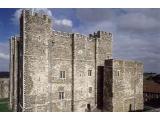Dover Castle and the Secret Wartime Tunnels
| |||||||||||||||||||||||
No fortress in England boasts a longer history than Dover Castle. Commanding the shortest sea crossing between England and the continent, the site has served as a vital strategic centre since Roman times. William the Conqueror strengthened the existing Anglo-Saxon fort in 1066, both Henry II and Henry VIII made their own additions, and Vice Admiral Ramsay famously oversaw the Dunkirk evacuations from the tunnels built into the cliffs beneath the castle. Dover’s wartime secret The White Cliffs are one of England’s most celebrated sights, yet hidden inside them is a fascinating and secret world. Deep underground lies an extensive network of tunnels – some first dug during the Napoleonic Wars, but so strategically useful that they continued to be used right through to the 20th century. Dunkirk evacuation – Operation Dynamo In May 1940 these tunnels provided the nerve centre for Vice Admiral Ramsay to plan The Secret Wartime Tunnels Operation Dynamo – the evacuation of British and allied troops from the Dunkirk beaches of northern France. Today you can tour the Secret Wartime Tunnels and experience life as it was lived by the 700 personnel based here in the worst days of World War II. You can see the Command Centre where Sir Winston Churchill viewed the Battle of Britain, and relive the drama as a surgeonThe 1216 Siege Experience, a stunning presentation using light, film and sound technology, highlights the stronghold’s key role in resisting invasion. It recounts the epic sieges of 1216-17, when Dover Castle held out almost alone for King John against rebel barons and their French ally Prince Louis. Henry VIII’s visit Following the annulment of his marriage to Catherine of Aragon, his excommunication by the Pope and the 1538 peace treaty between France and Spain, Henry VIII was isolated in Europe and a Catholic invasion of England seemed inevitable. The King commissioned a great chain of coastal artillery forts, coming to Dover in 1539 to inspect the work personally. An exciting exhibition at the castle offers a tableau of the preparations for Henry VIII’s visit. Very close to Dover you will find two more of Henry’s coastal defences, Deal Castle and Walmer Castle. Also of interest at the site are the Princess of Wales’ Royal Regiment Museum; one of the best-preserved Roman lighthouses in Europe; and the most complete Saxon church in Kent. The Stone Hut, originally built in 1912 for the Royal Garrison Artillery, has now been converted and is being used as an archaeological store for the South East. On the first Friday of every month (or by prearranged booking), visitors can view changing exhibitions of treasures from across the region, including Roman coins and pots, as well as artefacts from both World War II and the Cold War.
| |||||||||||||||||||||||
